Page 99 of 486
Running Your Engine While You’re Parked
(Automatic Transmission)
It’s better not to park with the engine running. But if you ever have to, here
are some things to know.
If you have four-wheel drive and your transfer case is
in NEUTRAL (N),
your vehicle will be free
to roll, even if your shift lever is in PARK (P). So,
be sure the transfer case is in a drive gear - not in NEUTRAL (N). Always
set your parking brake. Follow the proper steps
to be sure your vehicle
won’t move. See “Shifting Into
PARK (P)” in the Index.
If you’re pulling a trailer, see “Towing a Trailer” in the Index.
2-32 I
ProCarManuals.com
Page 102 of 486
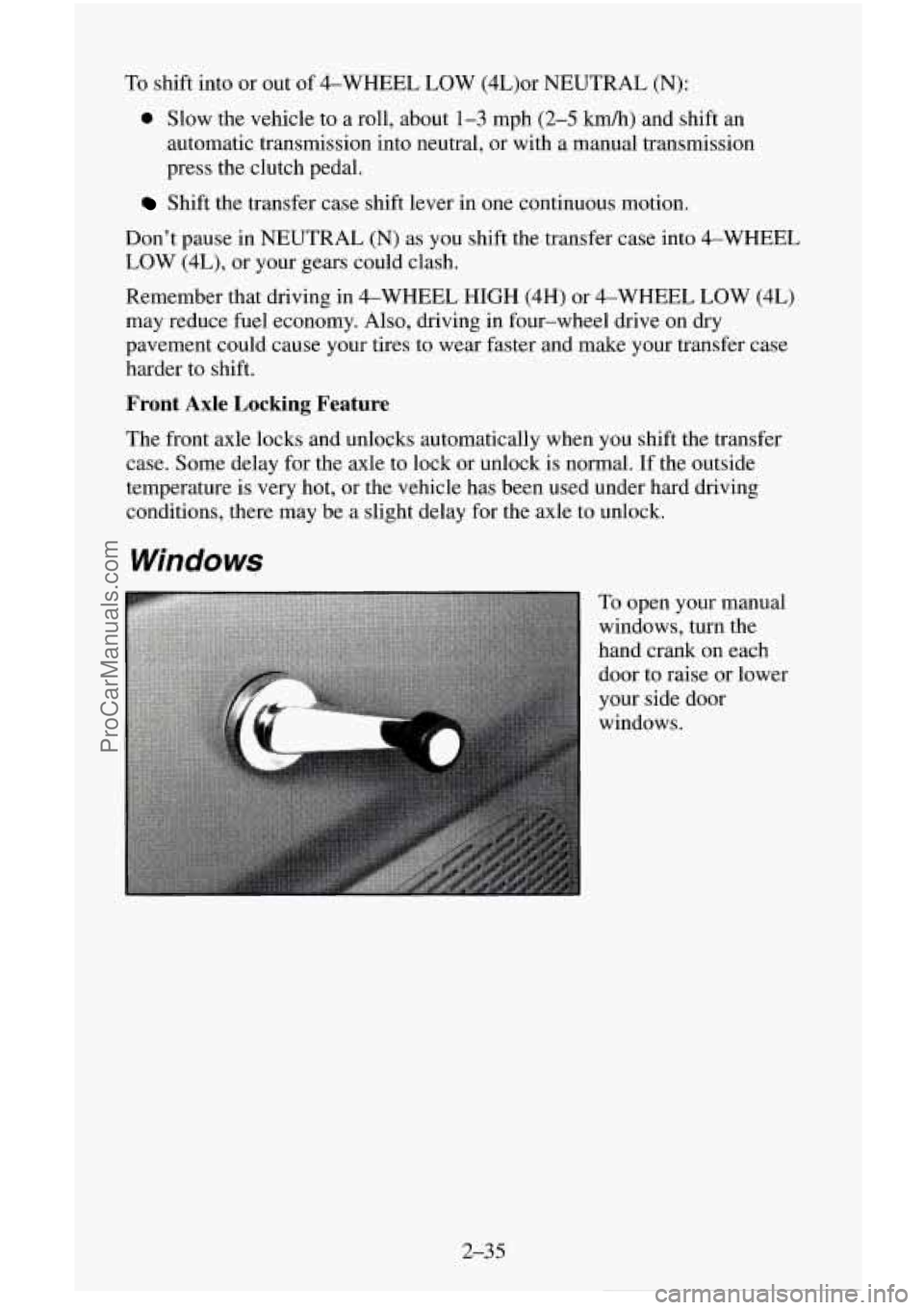
To shift into or out of 4-WHEEL LOW (4L)or NEUTRAL (N):
0 Slow the vehicle to a roll, about 1-3 mph (2-5 kdh) and shift an
automatic transmission into neutral, or with a manual transmission
press the clutch pedal.
Shift the transfer case shift lever in one continuous motion.
Don’t pause in NEUTRAL
(N) as you shift the transfer case into 4-WHEEL
LOW (4L), or your gears could clash.
Remember that driving in 4-WHEEL HIGH (4H) or 4-WHEEL LOW (4L)
may reduce fuel economy. Also, driving in four-wheel drive on dry
pavement could cause your tires to wear faster and make your transfer case
harder
to shift.
Front Axle Locking Feature
I ne front axle locks and unlocks automatically when you shift the transfer
case. Some delay for the axle to lock or unlock is normal. If the outside
temperature is very hot, or the vehicle has been used under hard driving
conditions, there may be a slight delay for the axle to unlock.
Windows
To open your manual
windows, turn the
hand crank on each
door to raise or lower
your side door
windows.
2-35
ProCarManuals.com
Page 104 of 486
Electric Tailgate Glass Release
Before operating your electric tailgate glass release, see the caution under
“Tailgate Glass, Tailgate and Rear Doors’’ in this section.
The electric hatch
release button lets
you
release the tailgate
glass. To release the
glass, press the top of
the switch button.
Then, lift the window
up
to open.
If you have an automatic transmission, your shift lever must
be in PARK (P)
or NEUTRAL (N) for the release to work. With a manual transmission, you
must apply the parking brake for the release to work.
2-37
ProCarManuals.com
Page 219 of 486
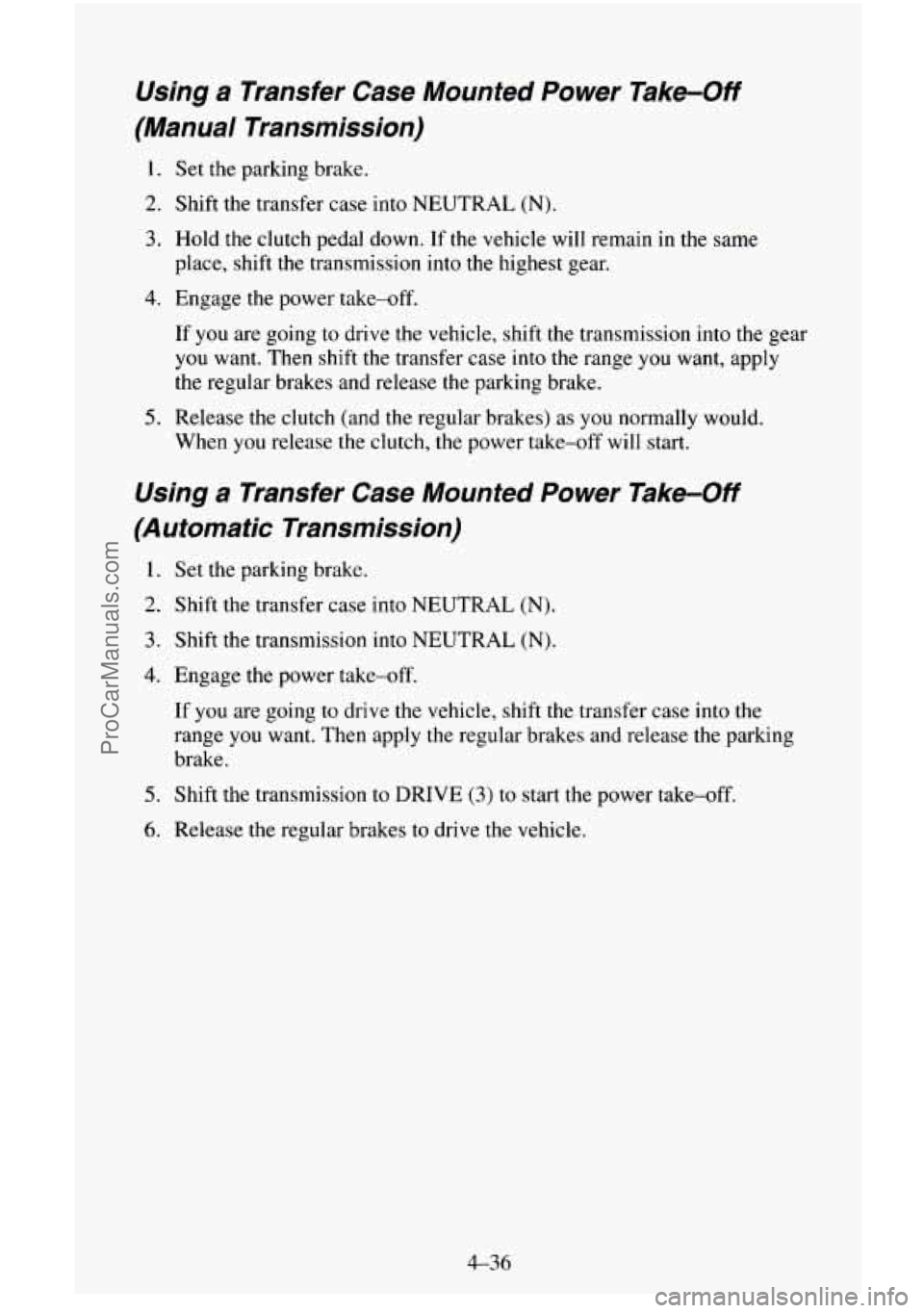
Using a Transfer Case Mounted Power Take-Off
(Manual Transmission)
1. Set the parking brake.
2. Shift the transfer case into NEUTRAL (N).
3. Hold the clutch pedal down. If the vehicle will remain in the same
4. Engage the power take-off.
place,
shift the transmission into the highest gear.
If
you are going to drive the vehicle, shift the transmission into the gear
you want. Then shift the transfer case into the range you want, apply
the regular brakes and release
the parking brake.
When you release the clutch, the power take-off will start.
5. Release the clutch (and the regular brakes) as you normally would.
Using a Transfer Case Mounted Power Take-Off
(Automatic Transmission)
1. Set the parking brake.
2. Shift the transfer case into NEUTRAL (N).
3. Shift the transmission into NEUTRAL (N).
4. Engage the power take-off.
If you are going to drive the vehicle, shift the transfer case into the
range you want. Then apply the regular brakes
and release the parking
brake.
5. Shift the transmission to DRIVE (3) to start the power take-off.
6. Release the regular brakes to drive the vehicle.
ProCarManuals.com
Page 223 of 486
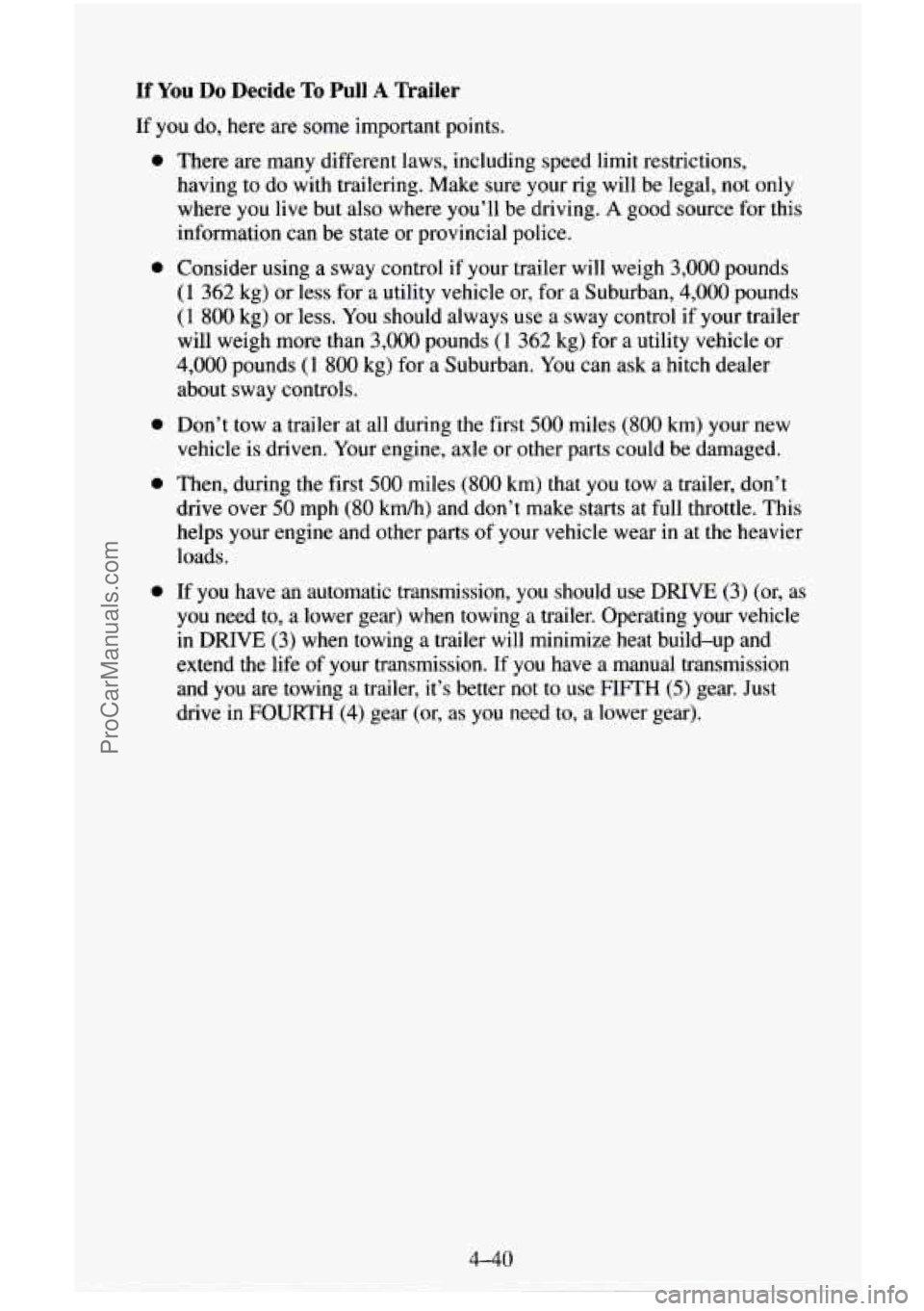
If You Do Decide To Pull A Trailer
If you do, here are some important points.
0
a
0
0
0
There are many different laws, including speed limit restrictions,
having to do
with trailering. Make sure your rig will be legal, not only
where you live but also where you’ll be driving.
A good source for this
information can be state or provincial police.
Consider using a sway control
if your trailer will weigh 3,000 pounds
(1 362 kg) or less for a utility vehicle or, for a Suburban, 4,000 pounds
(1 800 kg) or less. You should always use a sway control if your trailer
will weigh more than
3,000 pounds (1 362 kg) for a utility vehicle or
4,000 pounds (1 800 kg) for a Suburban. You can ask a hitch dealer
about sway controls.
Don’t tow a trailer at all during the first
500 miles (800 km) your new
vehicle is driven. Your engine, axle or other parts could be damaged.
Then, during
the first 500 miles (800 km) that you tow a trailer, don’t
drive over
50 mph (80 km/h) and don’t make starts at full throttle. This
helps your engine and other parts of your vehicle wear in at the heavier
loads.
If you have
an automatic transmission, you should use DRIVE (3) (or, as
you need to, a lower gear) when towing
a trailer. Operating your vehicle
in DRIVE (3) when towing a trailer will minimize heat build-up and
extend the life of your transmission.
If you have a manual transmission
and you are towing a trailer, it’s better not to use
FIFTH (5) gear. Just
drive in FOURTH (4) gear (or. as vou need to. a lower pearl
ProCarManuals.com
Page 228 of 486
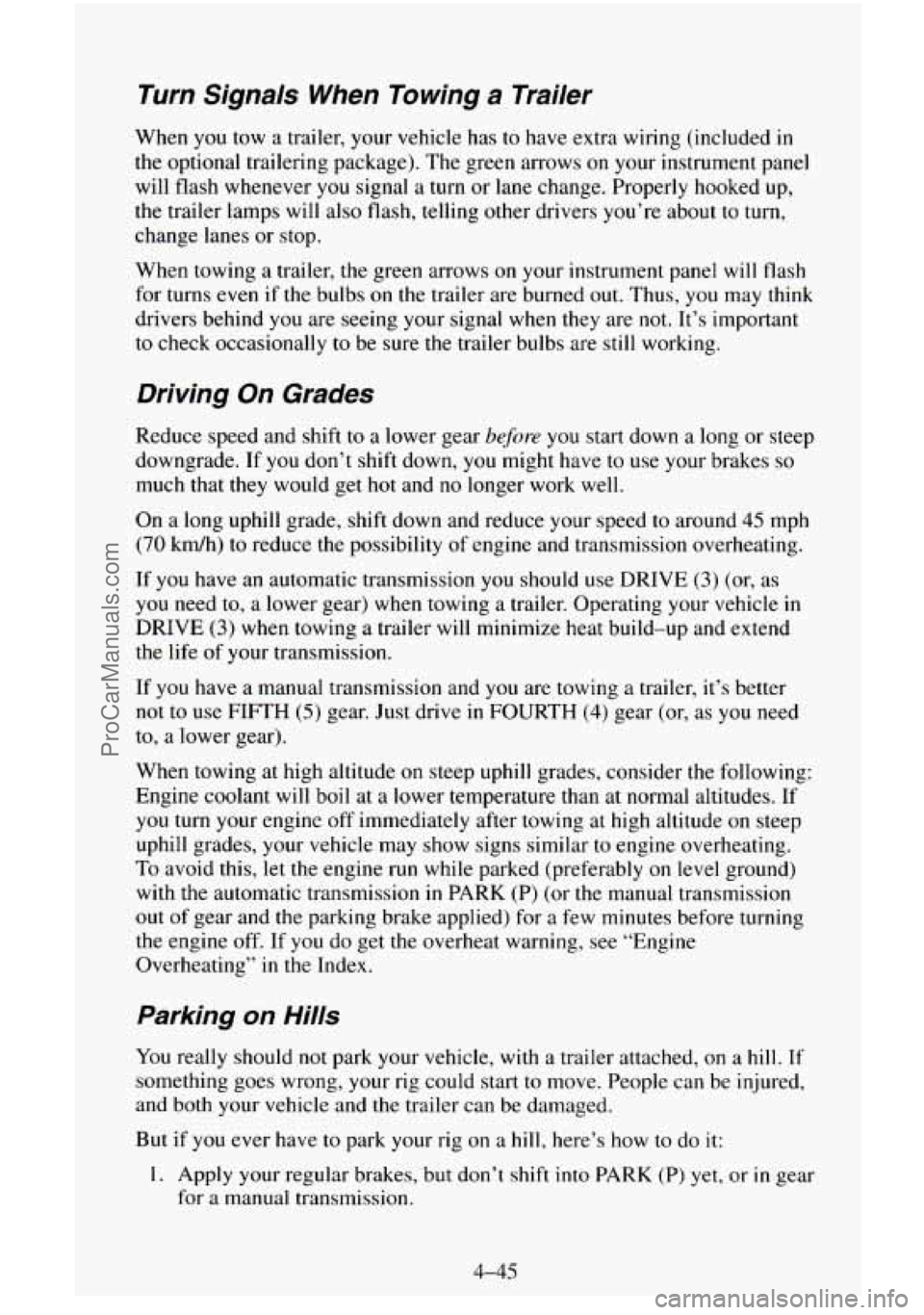
Turn Signals When Towing a Trailer
When you tow a trailer, your vehicle has to have extra wiring (included in
the optional trailering package). The green arrows
on your instrument panel
will flash whenever
you signal a turn or lane change. Properly hooked up,
the trailer lamps will
also flash, telling other drivers you’re about to turn,
change lanes or stop.
When towing a trailer, the green arrows on your instrument panel will flash
for turns even if the bulbs
on the trailer are burned out. Thus, you may think
drivers behind you are seeing your signal when they are not. It’s important
to check occasionally to be sure the trailer bulbs are still working.
Driving On Grades
Reduce speed and shift to a lower gear before you start down a long or steep
downgrade. If
you don’t shift down, you might have to use your brakes so
much that they would get hot and no longer work well.
On
a long uphill grade, shift down and reduce your speed to around 45 mph
(70 kdh) to reduce the possibility of engine and transmission overheating.
If
you have an automatic transmission you should use DRIVE (3) (or, as
you need to, a lower gear) when towing a trailer. Operating your vehicle in
DRIVE (3) when towing a trailer will minimize heat build-up and extend
the life
of your transmission.
If
you have a manual transmission and you are towing a trailer, it’s better
not to use FIFTH (5) gear. Just drive in FOURTH (4) gear (or, as you need
to,
a lower gear).
When towing at high altitude
on steep uphill grades, consider the following:
Engine coolant will boil at a lower temperature than at normal altitudes. If
you turn your engine off immediately after towing at high altitude on steep
uphill grades, your vehicle may show signs similar
to engine overheating.
To avoid this, let the engine run while parked (preferably on level ground)
with the automatic transmission
in PARK (P) (or the manual transmission
out of gear and the parking brake applied) for a few minutes before turning
the engine off.
If you do get the overheat warning, see “Engine
Overheating” in the Index.
Parking on Hills
You really should not park your vehicle, with a trailer attached, on a hill. If
something goes wrong, your rig could start to move. People can be injured,
and both your vehicle and
the trailer can be damaged.
But
if you ever have to park your rig on a hill, here’s how to do it:
1. Apply your regular brakes, but don’t shift into PARK (P) yet, or in gear
for a manual transmission.
ProCarManuals.com
Page 230 of 486
Maintenance When Trailer Towing
Your vehicle will need service more often when you’re pulling a trailer. See
the Maintenance Schedule for more on this. Things that are especially
important
in trailer operation are automatic transmission fluid (don’t
overfill), engine oil, axle lubricant, belt, cooling system, an\
d brake
adjustment. Each
of these is covered in this manual, and the Index will help
you find them quickly. If you’re trailering, it’s a good idea to review these
sections before you start your trip.
Check periodically to see
that all hitch nuts and bolts are tight.
Trailer Lighting Systems Wiring
See “Trailer Wiring Harness” in the Index.
ProCarManuals.com
Page 236 of 486
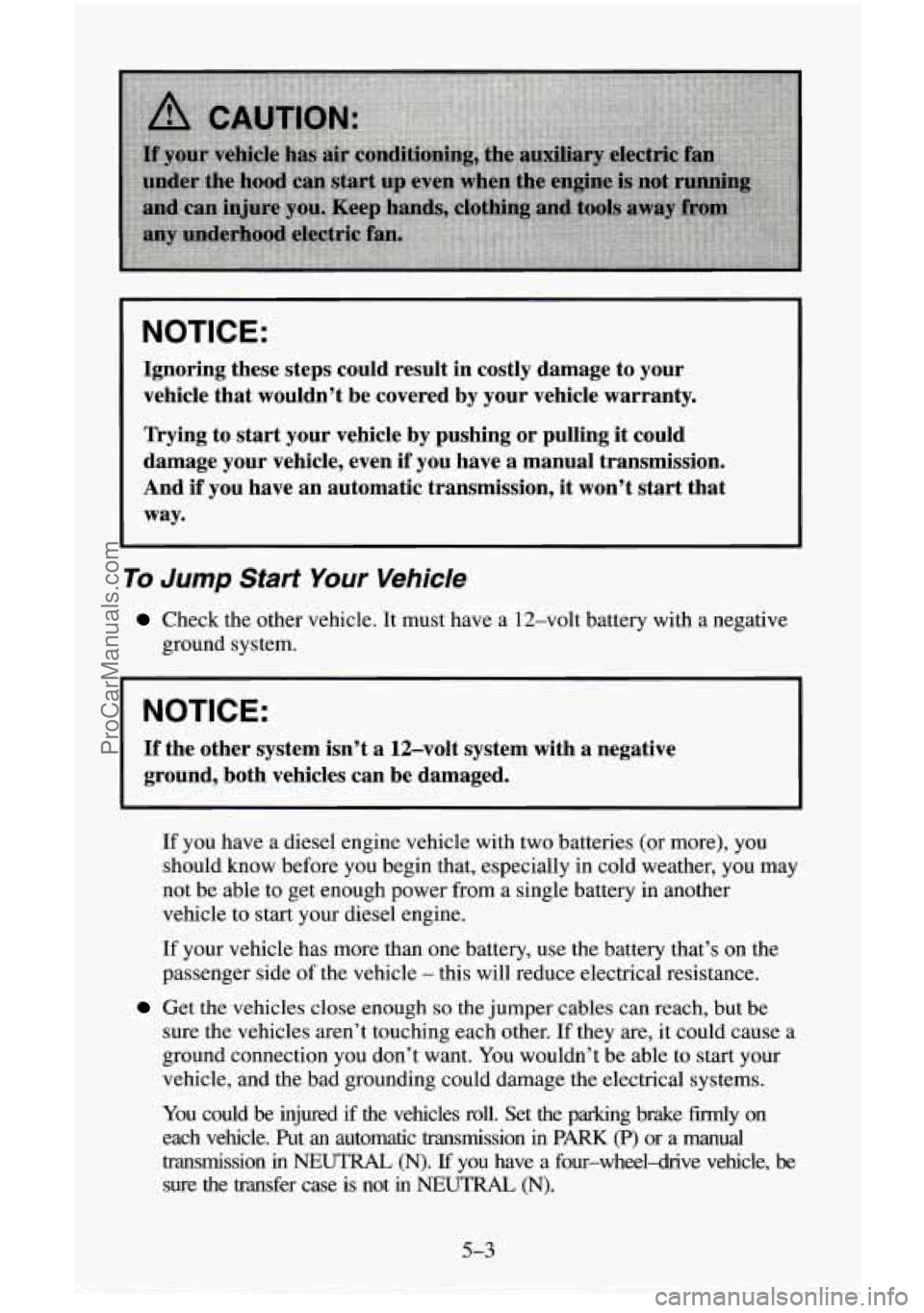
NOTICE:
Ignoring these steps could result in costly damage to your
vehicle that wouldn’t be covered by your vehicle warranty.
Trying to start your vehicle by pushing or pulling it could
damage your vehicle, even if you have a manual transmission.
And if you have an automatic transmission, it won’t start that
way.
To Jump Start Your Vehicle
Check the other vehicle. It must have a 12-volt battery with a negative
ground system.
NOTICE:
If the other system isn’t a 12-volt system with a negative
ground, both vehicles can be damaged.
If you have a diesel engine vehicle with two batteries (or more), you
should know before you begin that, especially
in cold weather, you may
not be able to get enough power from a single battery in another
vehicle
to start your diesel engine.
If your vehicle has more than one battery, use the battery that’s on the
passenger side
of the vehicle - this will reduce electrical resistance.
Get the vehicles close enough so the jumper cables can reach, but be
sure the vehicles aren’t touching each other. If they are, it could cause a
ground connection you don’t want. You wouldn’t be able to start your
vehicle, and the bad grounding could damage the electrical systems.
You could
be injured if the vehicles roll. Set the parking brake firmly on
each vehicle. Put
an automatic transmission in PARK (P) or a manual
transmission in NEUTRAL (N). If you have a four-wheel-drive vehicle, be
sure the transfer case is not in NEUTRAL (N).
5-3
ProCarManuals.com